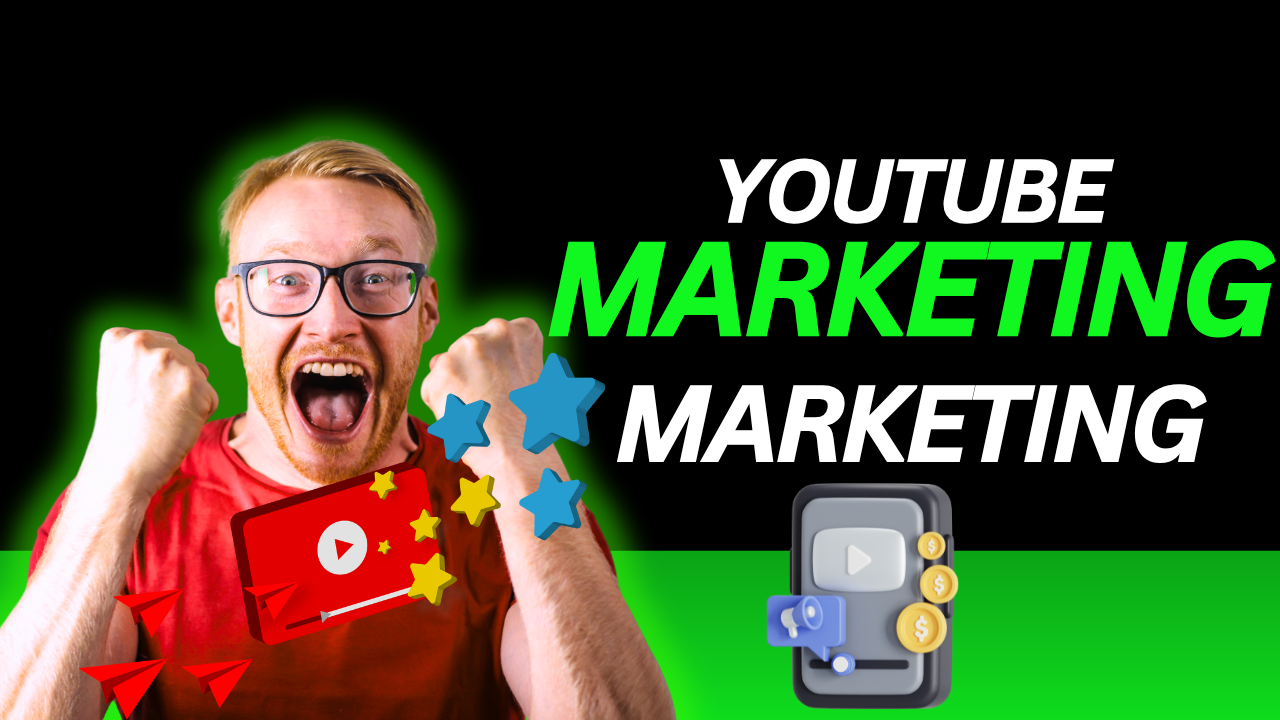Introduction
YouTube Marketing has become one of the most powerful platforms for digital marketing. With over 2 billion monthly active users, it provides businesses and content creators with an opportunity to reach a vast audience. If you are a beginner, understanding the basics of YouTube marketing can help you build your brand, generate traffic, and increase sales.
In this guide, we will explore the fundamental strategies of YouTube marketing, including content creation, optimization, promotion, and monetization.
Why YouTube Marketing Matters
- Massive Audience Reach: YouTube is the second-largest search engine, making it an ideal platform for reaching a global audience.
- High Engagement: Video content is more engaging than text or images, increasing watch time and user interaction.
- SEO Benefits: YouTube videos rank in Google search results, improving your visibility.
- Monetization Opportunities: Creators can earn money through ads, sponsorships, and affiliate marketing.
Step-by-Step Guide to YouTube Marketing
1. Create a YouTube Channel
The first step in YouTube marketing is setting up a branded channel. Follow these steps:
- Sign in to YouTube with your Google account.
- Click on your profile picture and select “Create a Channel.”
- Choose a name and upload a professional logo and banner.
- Fill out the “About” section with relevant keywords.
2. Research and Plan Content
Successful YouTube marketing requires strategic content planning. Here’s how you can do it:
- Identify Your Niche: Focus on a specific industry or topic.
- Analyze Competitors: Check out top-performing channels in your niche.
- Use Keyword Research Tools: Tools like Google Keyword Planner and TubeBuddy help find trending keywords.
- Create a Content Calendar: Plan videos in advance for consistency.
3. Optimize Videos for SEO
YouTube SEO helps your videos rank higher in search results. Follow these optimization tips:
- Title Optimization: Include primary keywords in the video title.
- Description: Write a detailed description with keywords and links.
- Tags: Use relevant tags to categorize your content.
- Thumbnails: Design eye-catching thumbnails to improve click-through rates.
- Subtitles and Captions: Adding subtitles enhances accessibility and boosts SEO.
4. Create High-Quality Content
Engaging content is key to retaining viewers and growing your channel. Follow these best practices:
- Start with a Hook: Capture attention within the first 5 seconds.
- Provide Value: Offer educational, entertaining, or problem-solving content.
- Keep it Concise: Ensure your videos are informative yet concise.
- Maintain High Production Quality: Invest in a good camera, microphone, and lighting.
5. Promote Your Videos
Once your video is uploaded, promotion is crucial for increasing views and engagement. Here are some effective strategies:
- Social Media Sharing: Share videos on Facebook, Twitter, LinkedIn, and Instagram.
- Collaborations: Partner with other YouTubers in your niche.
- Email Marketing: Send video links to your subscribers.
- Embed Videos on Your Website: Boost traffic by embedding videos in blog posts.
6. Engage with Your Audience
Engagement is essential for building a loyal subscriber base. Here’s how you can interact with viewers:
- Respond to Comments: Reply to comments to build relationships.
- Ask Questions: Encourage viewers to leave feedback.
- Host Live Streams: Live sessions increase real-time engagement.
- Create Polls and Community Posts: Use YouTube’s community features to engage followers.
7. Monetize Your Channel
Once you have built a solid audience, you can start making money through various methods:
- YouTube Partner Program: Earn ad revenue by enabling monetization.
- Affiliate Marketing: Promote products and earn commissions.
- Sponsored Videos: Collaborate with brands for paid promotions.
- Merchandising: Sell branded merchandise through YouTube’s shopping feature.
8. Analyze and Improve Performance
Regular analysis helps improve your YouTube marketing strategy. Use YouTube Analytics to track:
- Watch Time: How long viewers watch your videos.
- Audience Retention: Where viewers drop off in your videos.
- Traffic Sources: Where your views are coming from.
- Click-Through Rate (CTR): How often people click on your video.

YouTube Marketing Strategy: A Step-by-Step Guide to Grow Your Channel
YouTube has become one of the most powerful digital marketing platforms in the world. With over 2 billion logged-in monthly users, it’s a goldmine for brands, entrepreneurs, and creators aiming to grow their visibility, generate leads, and build a loyal community. But succeeding on YouTube requires more than just uploading videos—you need a well-defined marketing strategy. Here’s a complete guide on how to create a successful YouTube marketing strategy from scratch
1. Create a YouTube Channel
The first step in your YouTube marketing journey is setting up a professional YouTube channel. Fortunately, it’s a simple and quick process:
- Sign in to YouTube: Use your Google account to access YouTube. If you don’t have a Google account, you can create one for free.
- Create Your Channel: Click on your profile icon and choose “Create a Channel.” You’ll be prompted to enter a name and customize your channel settings.
- Choose a Channel Name: Pick a name that reflects your brand, niche, or content type. This can always be updated later.
- Add a Channel Description: Write a compelling bio that explains what your content is about and who it’s for. Include relevant keywords to improve discoverability.
- Customize the Layout: Upload a profile picture, banner, and create video sections to make your channel visually appealing and easy to navigate.
- Start Uploading Videos: With your channel live, you can begin uploading video content that aligns with your goals.
2. Define Your Target Audience
Knowing who you’re creating content for is critical to your YouTube success. A well-defined audience helps you tailor content that resonates, engages, and converts.
Consider these factors when identifying your YouTube audience:
- Demographics: Age, gender, location, income, and education help you understand who your ideal viewer is.
- Interests: Identify your audience’s hobbies and interests—tech, fitness, fashion, gaming, or finance—to align your content with their preferences.
- Viewing Behavior: Understand when, where, and how your audience consumes content. Do they prefer mobile over desktop? Short-form or long-form videos?
- Goals and Needs: Are they looking for how-to videos, product reviews, entertainment, or educational content? Knowing their intent lets you create content that solves problems or fulfills desires.
Once you have a clear picture of your audience, create content, titles, thumbnails, and descriptions that directly speak to them. This also improves the accuracy of your ad targeting if you choose to run YouTube campaigns.
3. Analyze Your Competitors
Competitive analysis is a critical part of building an effective YouTube strategy. Studying what similar channels are doing helps you identify trends, content gaps, and growth opportunities.
Key areas to evaluate:
- Content Type: Are they creating tutorials, product reviews, vlogs, or behind-the-scenes videos? This helps you brainstorm ideas for your own content calendar.
- Audience Demographics: Observe who your competitors are targeting. Can you serve the same group better, or is there an underserved niche you can focus on?
- Engagement Strategies: Look at how they interact with their viewers. Do they ask questions in their videos, encourage comments, or use community posts? Note what drives their engagement.
- SEO Optimization: Analyze how competitors use keywords in their titles, tags, and descriptions. Are their thumbnails eye-catching? This insight can help you improve your video discoverability.
- Ad Campaigns: Check if they are running YouTube ads. If so, what formats are they using—skippable ads, bumper ads, or in-feed videos? This helps you decide how to approach paid promotion.
- Performance Metrics: Look at subscriber growth, average video views, and comment activity. Use these numbers as benchmarks for your own channel.
By learning from successful creators and brands, you can avoid common pitfalls and develop a more competitive content strategy.
4. Create High-Quality Video Content
Quality content is the foundation of a successful YouTube channel. Make sure your videos are visually appealing, well-edited, and provide real value to the viewer. Plan scripts or outlines, use good lighting and audio, and invest time in post-production editing. Consistency is also key—stick to a schedule so your audience knows when to expect new videos.
5. Optimize Your YouTube Videos
YouTube is the second largest search engine, so optimizing your videos is essential for visibility. Use keyword-rich titles, detailed descriptions, relevant tags, and strong thumbnails. Add closed captions and organize your videos into playlists to boost engagement and watch time.

6. Monitor Channel Performance
Regularly review your analytics in YouTube Studio. Key metrics to track include watch time, click-through rate (CTR), audience retention, and subscriber growth. These insights help you understand what’s working—and what’s not—so you can refine your strategy.
7. Try YouTube Shorts
YouTube Shorts are short-form vertical videos that can help boost reach and engagement. They’re great for quick tips, behind-the-scenes content, or highlights from longer videos. Shorts appear in a separate feed and can go viral quickly, even for new creators.
8. Collaborate with YouTube Influencers
Partnering with influencers in your niche can expose your channel to a larger, engaged audience. Choose collaborators whose content aligns with your brand, and consider co-creating videos, hosting interviews, or doing shoutouts to increase visibility and credibility.
9. Invest in YouTube Ads
YouTube offers a range of ad formats to promote your channel and videos. From skippable in-stream ads to display ads and sponsored cards, paid campaigns can boost your reach, especially during product launches or promotions.
10. Track YouTube Analytics and Refine Your Strategy
Finally, always use YouTube Analytics to measure performance. Track key metrics like traffic sources, viewer demographics, and video performance. Use this data to double down on high-performing content and adjust your strategy for continued growth.
Conclusion
YouTube marketing is a powerful tool for businesses and content creators. By following these beginner-friendly strategies—creating valuable content, optimizing for SEO, engaging with your audience, and monetizing effectively—you can build a successful YouTube channel.
Start implementing these strategies today, and watch your channel grow into a profitable platform for your brand!




marketing site is best site
Thanks a lot my dear Friends.